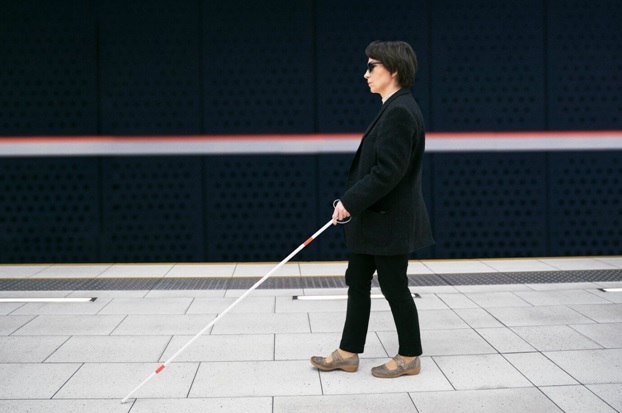Beyond Braille: Multi-Sensory Stairwell Signs for an Accessible World
Stairwells, while providing crucial escape routes and shortcuts between floors, can be daunting for anyone with visual impairments. Traditional braille signage, while indispensable, offers limited information and excludes individuals with additional sensory limitations.
But fear not, for the future of stairwell safety and accessibility lies in multi-sensory signage: a symphony of tactile textures, audio cues, and contrasting colors that caters to a wider range of abilities.
Benefits and Advantages of Accessible and Inclusive Architecture
Beyond the immediate benefits of empowering individuals with disabilities, accessible and inclusive architecture offers a ripple effect that touches everyone, making it not just a moral imperative but a wise investment for individuals, communities, and businesses alike.
Let's explore the far-reaching advantages of designing buildings with an all-encompassing lens:
1. Enhanced User Experience for All
It's not just about ramps and braille. Barrier-free design features like wider doorways, automatic doors, well-lit hallways, and clear signage benefit everyone, from parents with strollers and elderly individuals to temporary visitors carrying luggage. A welcoming and seamless flow within a building fosters a sense of ease and comfort for all users, regardless of their abilities.
2. Boosts Talent Pool and Workforce Diversity
When buildings are accessible, the talent pool for businesses and organizations expands significantly. A wider range of qualified individuals can apply for jobs and participate in activities, leading to a more diverse and inclusive workforce.
This diversity of perspectives and experiences fosters innovation, creativity, and problem-solving, boosting overall productivity and success.
3. Increased Customer Base and Market Reach
Businesses with accessible storefronts and facilities attract a broader customer base, including people with disabilities and their families and friends.
This translates to increased revenue and market share, as businesses cater to a previously untapped demographic.
Moreover, creating an inclusive environment demonstrates a commitment to social responsibility, enhancing brand image and customer loyalty.
4. Economic Advantages and Reduced Costs
Accessible design features often have dual purposes, making them cost-effective in the long run. For example, ramps can double as loading ramps for deliveries, and wider doorways benefit everyone moving furniture or equipment.
By removing physical barriers, businesses may also see a reduction in lawsuits and insurance claims related to accessibility issues. Additionally, accessible workplaces have lower rates of absenteeism and higher employee morale, leading to increased productivity and cost savings.
Beyond Touch: Feeling the Way
Think beyond the familiar raised dots of braille. Imagine stairwells adorned with textured strips that signal a change in direction or a rise/drop in elevation. These strips, strategically placed at the beginning and end of each step, can be made from rubber, cork, or even grooved metal, providing distinct tactile sensations underfoot.
This approach benefits not only individuals with complete vision loss but also those with low vision or light sensitivity who may struggle to see and feel for traditional Braille stairwell signs.
In addition, these textures can guide individuals with mobility impairments using canes or walkers, offering an extra layer of safety and confidence.
The Power of Sound: Guiding with Words and Melodies
Now, let's add a layer of sound to our stairwell symphony. Imagine discreet yet clear audio messages at the top and bottom of each staircase. These messages, available in multiple languages, can announce the floor number, direction of travel, or even safety reminders like "mind the gap." Such audio cues can be triggered by motion sensors or activated via Bluetooth, offering personalized guidance for specific needs.
For an extra touch of elegance, consider incorporating gentle musical chimes or melodies that change subtly at each floor. This not only provides auditory wayfinding but also creates a welcoming and calming atmosphere, especially for individuals with anxiety or hearing impairments who may find navigating stairwells stressful.
Seeing is Believing (or Touching and Hearing): Colors for Contrast
Visual cues, though not directly accessible to everyone, can still play a crucial role in multi-sensory signage. High-contrast colors strategically placed on handrails, walls, and steps can create clear visual boundaries and differentiate between stair treads and landings.
Consider using bright yellows or oranges for handrails, contrasting with darker wall colors for easy visibility.
Additionally, textured paint or raised patterns on the walls near the top and bottom of each staircase can offer additional tactile cues for those with low vision.
Combining Everything: Real-World Applications
Imagine a bustling airport. Travelers with diverse needs approach a staircase. Multi-sensory signage kicks in: textured rubber strips mark the first step, a gentle chime announces the floor number, and a high-contrast yellow handrail guides the way. This is not just a futuristic vision; it's a reality in several forward-thinking airports, museums, and public buildings around the world.
Schools and universities are also embracing multi-sensory signage. More than stairwell signs, tactile strips and audio cues at the top and bottom of each flight of stairs can aid visually impaired students, while contrasting colors can help individuals with dyslexia or attention deficit hyperactivity disorder (ADHD) stay focused and avoid potential falls.
The Future is Multi-Sensory
As technology advances and awareness grows, we can expect to see wider adoption of these innovative solutions, creating a truly accessible world where everyone can navigate stairwells with confidence and ease.
Remember, inclusivity is not just about ticking boxes; it's about creating a world where everyone feels safe, welcome, and empowered to navigate their surroundings.
If you’re on the lookout for Braille signs to supplement your multi-sensory structure and pave the way for a future where accessibility is not just a standard, but a celebration of diverse human experience, then feel free to browse through our selection here at Braille Sign Pros.






Comments
Post a Comment